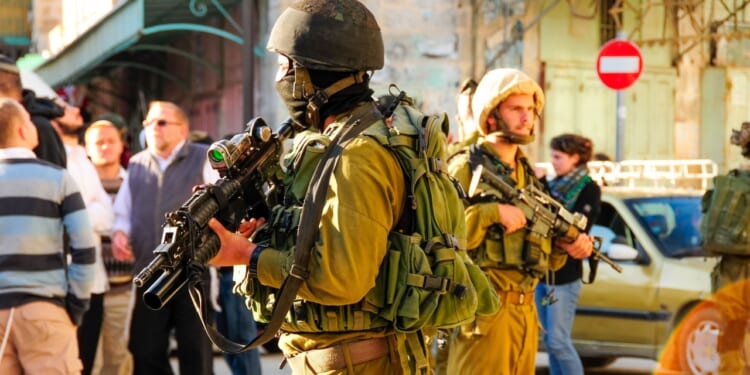On the second anniversary of the October 7 attacks, the causes, events, and aftermath of that day leave one crucial question to be addressed: Can Israel escape the Gaza trap?
October 7, 2025, marks two years since Hamas’ horrific attack on Israel’s southern communities that left 1,200 Israelis dead and some 251 Israelis taken hostage. This is an appropriate moment to explore what led to that event and especially how the evolution of Israel’s national security policy during the years prior to October 7 may have contributed to the horrific surprise that it suffered that day. No less important is an examination of the parameters and characteristics of the Gaza war that followed and whether a real opportunity exists to bring that terrible war to an end.
Israel, as is well known, does not have a formal process of articulating its defense strategy. It has no equivalents to the US Quadrennial Defense Review, the DOD’s Roles and Missions report, or the Annual Message of the Secretary of Defense to the US Congress. In the absence of such documents, Israeli strategy must be deduced from numerous, sometimes haphazard statements made by its leaders and senior defense officials, and more often from actions already taken.
As Israel’s first defense strategy was formulated during the country’s early years, it was largely informed by the experiences of Israeli leaders and members of its elite who survived the Second World War and the 1948 War of Independence. Not surprisingly, the basic assumption that guided these leaders was that their embryonic country was confronted by numerous adversaries who sought its destruction. Surrounded by hostile Sunni Arab states, Israel adopted a strategy to withstand these challenges by developing and maintaining a qualitative edge in as many facets of national defense as possible.
One corollary of this perspective was that the country’s numerical inferiority would mean the Israeli state would have to be proactive and avert threats before they materialized. Consequently, in the early 1950s, its defense forces pursued a highly aggressive “active deterrence” retaliation-centered posture against Palestinian terrorists (the Fedayeen) who infiltrated Israel from Egypt and Jordan. It also adopted “preventive wars” and “preemptive wars” as two offensive principles of its national defense strategy, launching such wars in 1956 and 1967, respectively.
Israel’s triumph in 1967 and its ability to withstand the serious challenges presented by Egypt’s conduct in the 1970 War of Attrition and its surprise launching of the 1973 October War, persuaded President Anwar Sadat that the conflict with Israel could not be resolved militarily. Thus, in November 1977, he launched his historic peace initiative, becoming the first Arab leader to travel to Jerusalem since independence. With the strongest and most populous Arab state removing itself any potential Arab coalition, many Israelis now concluded that they no longer faced existential threats. Indeed, some now went so far as to attempt more ambitious objectives.
Led by then Defense Minister Ariel Sharon in June 1982, Israel launched the First Lebanon War in pursuit of regime change in Beirut. As a result, the Palestinian militants who had become a formidable force in Lebanon after their expulsion from Jordan during Black September (1970) were now jettisoned yet again, this time to Tunis, as Israel hoped to replace them in Lebanon’s helm with leaders of the Maronite Christian minority.
On September 14, 1982, however, the Syrian-inspired assassination of Maronite leader, Bashir Gemayel, not only thwarted Israel’s grand design, but it also resulted in a different regime change for which Israel did not plan. The defeated PLO Chairman Yassir Arafat and the remaining Maronite Christian leadership lost prominence to the Shia Hezbollah movement, which gradually became the dominant force in Lebanon. Hezbollah’s determination to end Israel’s occupation of southern Lebanon as the first step to its aspired “March to Jerusalem” kept the IDF bogged down in that area for some eighteen years.
Then, only four months after Israel unilaterally withdrew from Lebanon in May 2000, Hezbollah’s apparent triumph inspired Palestinians in September 2000 to launch a four-year terror campaign against Israeli civilians, the Second Palestinian Intifada. During that period, Hezbollah continued to challenge Israel. In July 2006, it launched a particularly adventurous cross-border attack, dragging Israel back into Lebanon in another violent confrontation—the Second Lebanon War. The 34-day encounter ended in a draw, with a US-orchestrated, UN-formalized Israel-Lebanon ceasefire.
Despite Israeli worries that the IDF’s imperfect performance in 2006 eroded its deterrence, relative calm persisted along Israel’s northern border for the next 17 years. This allowed Israelis living there to maintain a mostly normal life and drew tens of thousands of Israelis from other parts of their country to spend their vacations there, resulting in a tourism boom.
Indeed, many Israelis now viewed “the quiet” achieved as semi-permanent and part of a broader geostrategic change. Israel’s peace agreements with Egypt and Jordan endured despite recurring tensions. Iraq, after 1980, embroiled itself in a horrific eight-year war with Iran and later suffered two monumental defeats in 1991 and 2003 by US-led coalitions, and no longer posed a strategic threat to Israel.
Initially, Iraq’s defeats, despite crowning Iran as the dominant power in the Gulf, benefited Israel unexpectedly. As the United States became immersed in the “forever wars” of Iraq and Afghanistan, Saudi Arabia, the UAE, and Bahrain began to see Israel as the only country able and willing to contain Iran. Thus, a new strategic environment emerged, characterized by extensive but covert defense and intelligence cooperation between Israel and several Gulf states, culminating with the signing of the US-orchestrated Abraham Accords in 2020.
The comfort of an increasing number of Arab states with regard to improved defense ties with Israel also allowed for even closer US-Israeli defense cooperation. As members of the IDF’s General Staff and directors of Israel’s Mossad entered Gulf palaces more frequently, the leaders of these states terminated their long-standing objections to including Israel in the region’s most effective defense institution: the US Central Command (CENTCOM). Stationed together with senior IDF officers under the same roof in Tampa, senior Arab military officers now dropped their previous reluctance to discuss their relations with their Israeli counterparts in public.
That change was further enhanced as top CENTCOM commanders pointed out that closer ties with Israel could also help to prevent it from taking measures that Arab leaders would likely view as destabilizing. This was apparent in the mid-2010s when Israel was seen as seriously weighing the possibility of bombing Iran’s nuclear facilities. While adamantly opposed to Iran’s nuclear ambitions, most Arab Gulf leaders were also worried that their states would become “soft targets” for Iranian retaliation. Now, as CENTCOM became an important framework within which such possibilities could be discussed, Israel’s inclusion made it less likely that it would ignore the US and Gulf states’ concerns.
Remarkably, just as US-Israel defense cooperation became closer than ever during the 2010s, so have Israel’s defense ties with Russia. This was especially important beginning in 2015, when Russia deployed significant naval and air force units in bases along Syria’s Mediterranean coast in an effort to save Bashar Assad’s regime. As Russia tried to avoid large-scale “boots on the ground” deployments, it relied primarily on its air force to hold Assad’s rivals at bay.
Focused almost exclusively on limiting Iran’s own involvement in Syria and its use of Syrian corridors to supply Hezbollah, Israeli prime minister Benjamin Netanyahu also understood the complexities of Russia’s interests in the region. Clearly, Russia shared Iran’s interest in preventing the collapse of the Assad regime. Still, in light of its experience with Chechnya, Moscow could hardly feel entirely at ease with an Islamist regime in Tehran.
Moreover, Russian president Vladimir Putin had no interest in confrontations between Russian and Israeli fighter pilots who were now operating in the same narrow theater of operations. That these operations continued in very close proximity for several years, largely without incident, is testimony to the meticulous tactical coordination exercised by the two air forces, and, no less important, to the depth of the strategic understanding reached between Netanyahu and Putin. Not surprisingly and not without cause, Netanyahu’s supporters advertised this achievement, crowning their leader as “in a league of his own.”
The Failure of “Conflict Management”
The relative “quiet” maintained along Israel’s northern border for a decade and a half since the Second Lebanon War has led the Israelis to believe that they can escape war by acting to preserve their security interests within tacitly agreed parameters. This included continuous yet limited military operations inside Syria aimed at preventing Iran and Hezbollah from establishing a military presence there and thwarting the transfer of weapons and military technology from Iran to Hezbollah through Syria.
In a rare diversion from its normal habits, Israel articulated this approach formally in the mid-2010s through the acronym OBWs—Operations Between Wars. A particularly important objective of these activities was to prevent the so-called “Accuracy Project,” in which Hezbollah attempted to improve the precision of its rockets and ballistic missiles with Iranian assistance.
During the same period, Israel appeared to be equally successful in “managing the conflict” in Gaza to the south. While ideologically Hamas was as committed as Hezbollah to Israel’s destruction, its immediate objective was to bring about an end to the siege that Israel and Egypt imposed on Gaza in the aftermath of Israel’s unilateral withdrawal from the area in 2005. That siege became especially tight after Hamas’ violent takeover of Gaza in 2007, and it became nearly hermetic after the Arab Spring, during which the Egyptians accused Hamas of intervening in their domestic affairs in support of the Muslim Brotherhood.
During the decade and a half prior to October 7, 2023, Israel “managed” its conflict with Hamas by exercising utmost restraint in an effort to achieve three strategic objectives: first, to allow Hamas to govern the Gaza Strip, thus institutionalizing the separation between Gaza and the West Bank; second, to limit Hamas’ ability to threaten Israel; and third, to prevent conditions in Gaza from deteriorating to the point that its population will feel that it has nothing to lose by launching a full-scale violent confrontation with Israel.
Preserving the separation between Gaza and the West Bank by allowing Hamas to govern the Gaza Strip served Israel’s Likud-led governments’ strategic aim of blocking a two-state solution to the Israeli-Palestinian conflict. Consistent with this goal, Israel never sought regime change in confrontations with Hamas in 2008–9, 2012, 2014, and 2021. Instead, more limited and vague objectives were stipulated, such as the “restoration of Israeli deterrence” or “changing the rules of the game.”
Unintentionally or deliberately, Israel also took measures that not only enhanced Hamas’ rule in Gaza but also strengthened it in its competition with its primary rival, the Fatah-led Palestinian Authority in Ramallah. One such step was the Gilad Shalit deal that allowed Hamas to take credit for the release of more than a thousand Palestinian prisoners from Israeli jails in exchange for a single Israeli soldier (in comparison to zero prisoners released to the PA).
Similarly, while Israel punished the Palestinian Authority for supporting families of terrorists who died or were serving jail terms by deducting funds from the money that Israel owed to the PA, the Israeli government worked diligently to make sure that the financial needs of the terror state of Hamas would be fully met.
A final dimension of Israel’s contribution to the strengthening of Hamas was the government’s tolerance of extremist Israeli groups creating provocations in Jerusalem’s Holy Basin (El-Haram al-Sharif) or attacking West Bank villagers. These provocations helped Hamas argue that the PA had abdicated its responsibility to care for the Palestinians in the West Bank and that Hamas was the sole effective protector of Arab rights in Jerusalem.
To keep Hamas in power, Israel allowed it to operate almost freely throughout Gaza and tolerated provocative activities “up to the fence.” This included refraining from using more aggressive measures to prevent thousands of Hamas supporters from protesting very close to the Gaza-Israel border, often endangering IDF soldiers standing on guard nearby.
It also meant muted responses to Palestinians’ use of incendiary balloons in July 2018, June 2019, and August 2020, to set fire to fields and plantations on Israel’s side of the border. Israel also tolerated the construction of watchtowers, such as the one that Hamas built just outside the Israeli border community of Netiv Ha‘assara in June 2022, allowing it to follow every movement in such locations. In none of these cases did Israel respond by using the lethal means that it deployed in the 1950s to establish and maintain deterrence.
Israel’s second strategic objective was to limit Hamas’ ability to threaten it. Achieving this required that all entry and exits would be tightly controlled, thus constraining the Palestinians’ ability to enter and leave the Gaza Strip. By severely limiting who and what enters the Strip, Israel was also responsible for the emergence of a robust smuggling sector in Gaza and for the skyrocketing prices of basic commodities. A case in point was the limitations imposed by the Israeli navy on Gaza fishermen’s access to its territorial waters. Each additional constraint made it harder for the fishermen to work, thereby increasing the price of the fish beyond what most Gazans could afford.
Israel’s third strategic objective was to prevent conditions in Gaza from deteriorating to the point that its population would feel that it had nothing to lose by launching a full-scale violent confrontation. Jerusalem attempted to achieve this by ensuring that Gaza would receive sufficient financial support, allowing its population to access at least the minimum means of sustenance and an adequate supply of water, electricity, and fuel. This effort included lobbying the leaders of Qatar to provide Gaza (that is, Hamas) with the financial means to purchase the goods needed to satisfy the population’s basic needs.
Ascertaining these requirements involved Israel in macabre calculations about the Gazan population’s minimal caloric intake needs and in monitoring the extent to which these needs were met. In the years just before October 7, Israel also tried to increase the Gazans’ purchasing power by allowing up to 17,000 Palestinians to cross into southern Israel daily in pursuit of employment opportunities there.
To summarize, for 16 years since Hamas’ takeover of Gaza, the conflict between Israel and Hamas continued within similar parameters as those between Israel and Hezbollah. Hamas continuously sought ways to demonstrate its commitment to battle Israel, while the latter attempted to limit Hamas’ capabilities but refrained from initiating war to achieve Hamas’ destruction. Instead, Israel focused on keeping Hamas within a set of operational boundaries by reminding it periodically of the costs associated with any serious effort to cross these boundaries —a policy two Israeli analysts coined as “mowing the grass.”
The October 7 Catastrophe
Israel’s elaborate Gaza policy collapsed completely on October 7, 2023. Israel’s colossal strategic surprise that day was not the result of failures to identify specific movements and preparations by Hamas for its horrific attack or to understand such preparations and movements once they began. Nor was it primarily the result of its intelligence community dismissing certain observables and documents obtained during the years, months, and weeks prior to the attack as insignificant.
Rather, October 7 came as a colossal surprise because, in adopting a complicated conceptual framework, Israeli leaders had failed to question the validity of their assumptions and ascertain the risks inherent in its “conflict management” strategy.”
In retrospect, it appears that Israel’s success in achieving relative stability may have prevented it from recognizing what was brewing beneath the surface. Indeed, such success created two parallel realities at the time. Globally and regionally, Israel could not be more gratified by the array of relationships it succeeded in establishing in the Middle East and by its success in building closer defense ties with the United States than ever before. At the same time, in its immediate surroundings, Israel failed to see that Hamas was slowly but deliberately building the capacity to undermine the pillars upon which the stability rested.
The first of these two errors was a failure to appreciate the extent to which Israel’s success in building ever so intimate defense cooperation with the United States, as well as with several Gulf states within the Abraham Accords (with Saudi Arabia waiting in the background to join), was perceived by Iran as a mortal threat. To thwart this threat, the Islamic Republic invested enormous resources in the “Axis of Resistance,” including Hezbollah, Hamas, Syria’s Assad regime, Yemen’s Houthis, and pro-Iran militias in Iraq.
Israel’s intelligence community was aware of almost all that took place within the axis, but it did not appreciate the significance of these developments. Moreover, Israel assessed that the estimated 130,000 rockets and missiles that Hezbollah had accumulated, despite Israel’s extensive OBW operations, were intended exclusively to deter it from attacking Iran’s nuclear facilities. Thus, the possibility that this arsenal would be sacrificed in support of another member of the axis was not considered seriously before October 7.
Closer to home, Israel failed to appreciate that its work to institutionalize Hamas’ hold over Gaza was being exploited by Hamas to achieve a completely different objective, namely, to build a robust military arm and challenge the status quo, not preserve it. Thus, Hamas succeeded where most non-state actors failed. It trained and deployed foot soldiers, single-prop gliders, drones, and naval commandos, creating something resembling a combined-arms force.
Assuming its absolute superiority, the Israeli intelligence community dismissed Hamas’ buildup and its closely observed preparations as fanciful if not laughable. But with this capacity, built over almost a decade of procurement, production, training, and exercises, Hamas achieved what Israel assessed as impossible. Its militants breached the high-tech border fence at more than 30 locations and overcame the steel barrier that Israel installed along that border at a heavy cost after the 2014 confrontation revealed Hamas’ capacity to construct attack tunnels.
The shock that Israel experienced on October 7 exceeded the heavy toll that it suffered: over 1200 soldiers and civilians were slaughtered, and 251 Israelis, mostly civilians of all ages, were taken hostage. For the first time since the end of the 1948 war, an adversary—this time a non-state actor—succeeded in overcoming IDF troops to conquer sovereign Israeli territory and to hold on to that territory for many hours. Hamas achieved this by blinding Israeli sensors along the fence as well as by overtaking the ill-defended headquarters of the Gaza Division, which was charged with commanding and coordinating all IDF units positioned around Gaza.
Without any capacity to integrate the information received and to form an accurate portrait of the battlefield to be conveyed to the IDF’s Southern Command and General Staff, the latter lacked the essentials required to orchestrate an effective Israeli response to the chaos that prevailed during the first hours of the war.
In retrospect, however, it seems that Hamas was just as surprised as Israel by its initial success, and it was unprepared for the consequences of that success. Had it considered the ease with which it might overtake the Gaza Division headquarters and the Israeli communities located along the border as a realistic scenario, it might have taken measures to limit the brutality of its fighters and to prevent Palestinian civilians residing in communities on the Gaza side of the border from entering the breached fence and joining the slaughter.
This was especially the case with the Nova Festival, which Hamas may not have even known about. The event offered an unexpected opportunity to murder more than 300 Israeli youths without much effort. By totally failing to impose limits on the slaughter and destruction, Hamas condemned Gaza’s population to the brutal Israeli response that followed.
The Ensuing Gaza War
In the immediate aftermath of the October 7 horrific attack, Israel made several strategic decisions that together comprised its approach to the ensuing Gaza War. The first of these was to articulate Israel’s primary war aims: to destroy Hamas’ capacity to fight and to eliminate Hamas’ ability to govern the Gaza Strip. Another part of that decision, articulated soon thereafter by the newly formed War Cabinet, was to focus Israel’s effort by invading Gaza with significant ground forces (“the maneuver”) while “holding” on all other fronts, thus also postponing a major military confrontation with Hezbollah.
A related second strategic decision—this one seems to have been taken on by the IDF’s General staff but approved by the war cabinet—was that the large-scale “maneuver” into Gaza beginning in late October 2023 would first focus on the northern part of the Strip. To reduce casualties among uninvolved Palestinians, it was also decided that the Palestinian population in the north would be directed to move to “secure areas” in the central and southern parts of the Strip.
The decision to focus initially on the north was not changed until many months later, when in May and June 2024, the IDF’s main effort in Gaza shifted to the southern part of the Strip, to gain control of Khan Yunis, Rafah, and the Philadelphi Corridor that runs parallel to the Egypt-Gaza Border.
In a televised statement to the Israeli public on September 2, 2024, Prime Minister Netanyahu elevated the importance of these locations to an “existential” level due to their proximity to Egypt’s borders, which were shown to comprise Hamas’ lifeline. Why it took so many months to discover the significance of these locations, where all previous Israeli wartime invasions of Gaza began (in 1949, 1956, and 1967), was never explained.
The emphasis on the south was changed, again without explanation, when a decision was made in August 2025 to launch a new, more robust military effort in Gaza. The thrust of this new effort was yet again in the north, with particular emphasis on Gaza City and other areas where the IDF was said to have eliminated Hamas’ control a year and a half earlier.
The third major decision was to add the release of the Israeli hostages taken by Hamas on October 7 as the third primary objective of war. In a number of respects, that decision significantly affected the character of the fighting over the following two years. First, as Hamas conditioned the release of the hostages on ending the war and on Israel’s complete withdrawal from Gaza, the hostages’ release required that Israel abandon one of its primary aims: to end Hamas’ governing of the Gaza Strip. As it refused to accept this demand, Israel could not but reject every “all for all” proposal for a hostage release deal.
Another way that the decision to give the release of the hostages near top priority affected the fighting was related to another facet of Israel’s modus operandi in Gaza, namely the use of statistical ordnance. This caused massive Palestinian casualties and destruction. Given such use, the priority given to hostage release compelled the IDF to avoid entering locations where intelligence indicated that Israeli hostages were likely to be held. This, in turn, allowed Hamas to continue to exercise control in these areas and to launch limited attacks against IDF troops who maneuvered in proximity to these locations. It also damaged the IDF’s credibility as its senior officers and spokespersons announced the destruction of large adversary formations such as battalion and brigade commands. At the same time, Hamas’ continued operations demonstrated that its fighting capacity was not entirely defeated.
The fourth major decision made by Israeli leaders and senior IDF officers was largely informed by the sheer anger at Hamas’ brutality on October 7 and the Israeli determination to avoid suffering additional casualties. The resulting imperative of minimizing Israeli casualties in battle led to the decision to deploy heavy armor and keep a considerable distance from the adversary by using statistical firepower such as tank and artillery shells, as well as airpower.
The destructive power of such weaponry does not make distinctions between fighters and civilians in densely populated areas. By the time of writing, that toll reached roughly 67,000 Palestinian dead and 170,000 wounded of both genders and all ages. With few Hamas fighters wearing uniforms, the distinction between soldiers and civilians, and between fighters and uninvolved, is blurred, especially as Gaza’s very dense population provided—willingly or unwillingly—a human shield to Hamas fighters.
The fifth and final decision taken may have been the most consequential of all, although it comprised little beyond a decision not to decide. Led by Prime Minister Netanyahu, the decision was to avoid any discussion of an “exit strategy,” that is, to refrain from articulating conditions for stopping the war and withdrawing from Gaza.
At the insistence of then Minister of Defense, Yoav Gallant, Israel also ruled out the application of a “military government” in parts of Gaza where Hamas would be defeated. Moreover, Israel also refused to consider the construction of any alternative mechanism for governing Gaza, especially one that might entail the participation of the Palestinian Authority. Such involvement was seen as establishing the nucleus of a future Palestinian state—a possibility that Israel’s Likud-led government rejected entirely.
The decision not to decide on any vision of “the day after” also ruled out any suggestion of welcoming Arab states to send police or military units to replace the IDF’s hold on Gaza. The basis for this rejection was that the relevant Arab states made their participation in such a project contingent on being invited to do so by the Palestinian Authority—a condition that the Israeli government would not accept.
In turn, the refusal to apply a “military government” while also rejecting the entry of other Arab forces to replace the IDF in Gaza forced the IDF to adopt an “in-and-out” modus operandi, that is, of instructing IDF units to move out of areas soon after dismantling terror infrastructure. This also contributed to the prevailing confusion of Israelis about the war as IDF units were reported as having been redeployed in areas where Hamas was said to have been defeated weeks or even months earlier.
A related ramification of this constraint was that any Israeli success in meeting the war’s second aim—namely, destroying Hamas’ governing capacity—could only produce a vacuum. In turn, all haphazard Israeli efforts to fill this vacuum by employing non-Hamas, family-based (Hamula) entities, or by contracting American firms to administer the distribution of food, proved to be colossal failures. The result was a diplomatic catastrophe as no one other than Israel would be held responsible for the chaotic and horrific scenes of death and destruction that accompanied Israel’s war on Hamas.
Where to Go from Here?
On the second anniversary of October 7, the causes, events, and aftermath of that day leave one crucial question to be addressed: Can Israel escape the Gaza trap? Two sets of important developments may prove relevant to reaching a slightly less depressing conclusion to this essay than would have been the case otherwise.
The first of these sets is that at the same time that Israel has dug itself deeper into the Gaza quagmire, the qualitative edge that it has built and cultivated since its inception allowed it to score a remarkable feat: the destruction of the “Axis of Resistance” that its Iran-led adversaries have constructed around it. Using sophisticated intelligence to locate targets and the most advanced technology to destroy these targets once located, Israel managed to strike a powerful blow to the most robust of its immediate adversaries: Hezbollah. This took place after the movement’s military arm had already exhausted most of its ballistic missiles and rocket stockpiles during its months-long attempt to attrit Israel.
Israel’s September 2024 transformation of pagers into weapons of semi-mass destruction that took out some 3,500 Hezbollah operatives was a major blow to the military arm of the Shia movement. As this was followed on September 27 by the targeted killing of Hezbollah’s charismatic leader, Hassan Nasrallah, the movement now lost its uniquely talented shepherd.
The second development that favored Israel significantly was the collapse of the Assad regime, the conduit through which Iran had supplied Hezbollah with weapons and munitions for two decades. Assad’s surprise flight to Russia in December 2024 and the remarkable success of Ahmad al-Shara in taking Damascus were yet more strategic surprises for the region.
Soon enough, al-Shara used several channels to communicate that he has no interest in perpetuating Syria’s conflict with Israel. At the time of writing, Israeli, US, and Syrian sources have all indicated that al-Shara and Netanyahu are close to concluding a defense agreement that may extend beyond simply restoring the Israeli-Syrian Disengagement Agreement, which then-Secretary of State Henry Kissinger mediated in 1974.
The third significant development of this period was the substantial shift in the distribution of power between Israel and Iran. In April and November 2024, together with the United States and its Arab partners and coordinated by CENTCOM, two Iranian attempts to strike Israel with drones and ballistic missiles were thwarted. The exchange damaged Iran’s missile and drone production as well as its air-defense systems considerably, leaving the Israeli air force clear corridors for striking targets deep inside Iran.
By June of this year, however, it became clear that these two earlier confrontations were mere promos to a 12-day full-scale military confrontation between the two countries, leaving Iran’s nuclear facilities seriously damaged. Regardless of how far the Israeli and US strikes pushed back Iranian efforts to build a nuclear infrastructure, Iran’s consent to a ceasefire on June 24 was a massive blow to the Tehran-led axis.
The three aforementioned trajectories that altered the regional balance of power in Israel’s favor were accompanied by a significant yet largely unnoticed shift in Israel’s defense strategy, returning it full circle to its origins in the 1950s. All references of the previous decade to the possibility of “managing the conflict” were now replaced by a commitment to thwart threats before they materialize and respond aggressively to Yemen’s Houthis and attempts to restore Hezbollah’s positions in southern Lebanon.
Israel also took precautionary measures in Syria, positioning IDF units east of the 1974 Disengagement lines and launching OBW-type air and commando operations in January, July, and August 2025 against arms manufacturing facilities and weapons stockpiles deep within Syrian territory.
Now, another facet of Israel’s first national defense strategy was resurrected: its alliances with the region’s minorities. Partly fueled by Israeli domestic pressures exerted by Israel’s Druze minority, Israel struck targets in southern Syria in July 2025. The operation was intended to protect the Druze community residing there, who had been attacked by their Bedouin neighbors, with unclear support from officials of the new regime in Damascus.
The regional developments ascertained here, along with the recent developments in Israel’s more immediate security environment, now provide its leadership with a uniquely welcoming environment for grasping the lifeline tossed in Israel’s direction by US president Donald Trump.
Notwithstanding the many unanswered questions about President Trump’s 20-point peace plan, for the first time since October 7, a path to escape the Gaza trap has opened. How Israel will respond to this opportunity—not in purposefully vague statements, but in actual deeds—and to the challenges and risks that the plan entails, will be another crucial test of the country’s old-new, yet to be articulated, national defense strategy.
About the Author: Shai Feldman
Shai Feldman is the Raymond Frankel Chair in Israeli Politics and Society at Brandeis University’s Crown Center for Middle East Studies.
Image: Mohannad Khatib / Shutterstock.com.


















